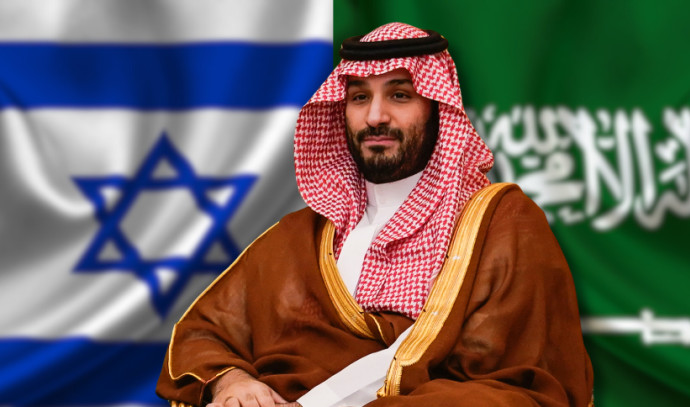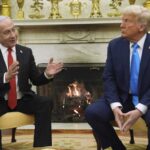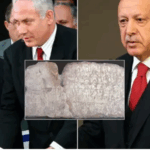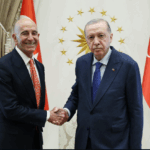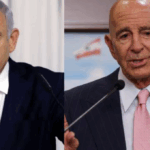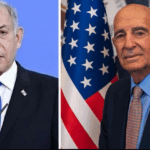In December 2024, Bashar al-Assad quietly slipped into exile in Russia after being ousted by Hay’at Tahrir al-Sham (HTS), a jihadist group ideologically aligned with Saudi-backed Salafism. It was a historic moment—marking the fall of the last Arab regime openly opposed to Israel’s dominance and signaling the final collapse of pan-Arab nationalism, which had also posed a threat to the House of Saud.
But Assad’s fall was no isolated event. It was the endgame of a century-long geopolitical project in which Saudi Arabia, along with Erdoğan’s Turkey and Iran, has played a central role—not as a passive monarchy, but as an active agent of imperial and Zionist fragmentation. From its British-engineered origins to its recent embrace of normalization with Israel, the Saudi state has consistently undermined every attempt at Arab unity, Islamic solidarity, and strong Muslim statehood across the region.
A Manufactured Monarchy
Saudi Arabia’s creation was not the natural evolution of tribal unity or a revivalist religious movement—it was, from its inception, a colonial intelligence project, carefully designed to fracture the Islamic world and dismantle any possibility of pan-Islamic resistance. As early as the 18th century, British imperial strategists identified Wahhabism, a harsh, puritanical doctrine emerging in the Najd region, as an ideal ideological weapon to undermine the Ottoman Empire’s religious legitimacy and political cohesion. Wahhabism’s hostility toward Islamic pluralism made it a perfect fit for British plans to divide Muslims and weaken the Caliphate. This vision was operationalized in 1916, when Britain backed the Arab Revolt against the Ottomans—an uprising framed as liberation but instrumentalized to pave the way for Zionist ambitions in Palestine and the rise of British-aligned monarchies like the House of Saud.
With the First World War came the decisive blow: the collapse of the Ottoman Empire not only marked the end of the Caliphate but created the political vacuum into which two of the most consequential colonial projects in modern history would be inserted—the Kingdom of Saudi Arabia and the State of Israel. The British simultaneously backed the Zionist movement through the 1917 Balfour Declaration while propping up Ibn Saud to seize power in the Arabian Peninsula. The Hashemites—direct descendants of the Prophet Muhammad and traditional custodians of the holy sites—were pushed aside and exiled to Jordan, replaced by a tribal monarchy engineered to serve foreign interests.
Behind this political engineering lay a deeper secret. Multiple revisionist accounts assert that the Al Saud family descended from crypto-Jewish merchant clans who publicly converted to Islam while privately maintaining their distinct religious and cultural identity. Sources such as Memoirs of Mr. Hempher (2004) and works circulated in Arab nationalist circles argue that these merchant elites, aligned with British objectives, acted as embedded agents of imperial fragmentation. Whether this lineage is taken literally or interpreted symbolically, its political consequence is undeniable: the House of Saud has consistently functioned not to unify the Muslim world, but to divide, weaken, and control it.
This hidden lineage explains the dynasty’s obsessive hostility to any form of Islamic pluralism or political independence. From its earliest days, the Saudi state—with Wahhabi clerics at its side—moved swiftly to crush Sufi orders, persecute Shiite communities, and outlaw any discourse that challenged its absolutist authority. Pan-Arabism, Islamic socialism, and Palestinian resistance were all branded heretical—not because they violated Islam, but because they threatened the geopolitical order Saudi Arabia was built to protect.
The alliance between Wahhabism and the Saudi monarchy functioned as a theological smokescreen for imperial control. Internally, it sanctified repression, obedience, and dynastic rule. Externally, it gave the West a convenient partner to contain and discredit Islam, sabotage Arab unity, and justify endless intervention. In this way, Saudi Arabia became the ideological mirror of Israel: both were artificial states constructed on the ruins of the Ottoman order, both imposed by imperial fiat, and both designed to ensure that the Arab world would never rise united again.
This project was sealed in 1945 when U.S. President Franklin D. Roosevelt met with King Abdulaziz aboard the USS Quincy. That meeting laid the foundation of the petrodollar system and Saudi Arabia’s role as a loyal supplier of oil and sectarian ideology in exchange for U.S. military protection and political impunity.
Wahhabism: Weapon of Mass Disunity
Wahhabism, exported globally by Riyadh with billions in petrodollar support, has not merely shaped religious discourse—it has weaponized theology to serve geopolitical ends. Packaged as Islamic revivalism, Wahhabism was in fact a doctrinal hammer aimed at the foundations of both Islamic pluralism and Arab nationalism and sovereignty. Across the Muslim world, it actively undermined traditional religious authorities, suffocated intellectual inquiry, and cast political resistance as heresy.
The real effect was catastrophic. Wahhabism turned centuries of Islamic diversity into a rigid binary: conform or be condemned. It delegitimized spiritual Islam, excommunicated nationalist thinkers, and denounced resistance movements in Palestine and elsewhere as “deviants.” In doing so, Wahhabism became the theological scaffolding for authoritarianism, reinforcing monarchs, silencing opposition, and discrediting political participation across the Arab world.
Nowhere was this clearer than in Saudi Arabia’s Cold War strategy. The Kingdom worked in tandem with the United States and Israel to neutralize pan-Arabism and anti-imperialist currents. In Yemen in the 1960s, Riyadh and Tel Aviv both supported royalist forces against Egyptian-backed republicans, fearing Nasser’s populist wave would awaken the region. Saudi-backed clerics declared Nasserist ideology “apostasy,” while Israeli intelligence shipped weapons to monarchist fighters—establishing an undeclared alliance that would persist for decades.
In the 1980s, this covert collaboration between Israel and Saudi Arabia reached a critical phase. While Israel was secretly funneling arms to Iran during the Iran-Iraq War, its objective was not to support the Islamic Republic ideologically, but to prolong the conflict and fatally weaken Saddam Hussein’s pan-Arabist regime—a leading voice for Palestinian liberation and Arab self-determination. Crucially, Israel had no interest in the rise of either Sunni orthodoxy or Shiite revolutionism, both of which could eventually threaten its regional dominance. Its strategy was to simultaneously destroy pan-Arabism and ensure no Islamic trend—Sunni or Shia—gained supremacy. Saudi Arabia, sharing these objectives albeit from a sectarian and monarchic perspective, channeled money, weapons, and ideological training into Afghanistan, where it sponsored the rise of Wahhabi-infused jihadist groups. These militants—celebrated in the West at the time as “freedom fighters”—formed the backbone of what would later become al-Qaeda, an organization ideologically shaped by Saudi-funded madrassas and clerics. Thus, under the pretext of confronting communism and Iran, Israel and Saudi Arabia operated on parallel tracks: dismantling nationalist regimes, exporting chaos, and erecting a new regional order where neither religious authenticity nor political independence could take root.
But the most profound impact of Wahhabism was not military—it was epistemological. Across Egypt, Pakistan, Indonesia, and North Africa, Saudi-funded institutions rewrote religious curricula, replacing centuries of Islamic jurisprudence, mysticism, and humanist ethics with dogmatic literalism and sectarian paranoia. It cultivated a generation of Muslims disconnected from their cultural heritage and primed for either passive obedience to tyranny or fanatical violence against “heretics.”
By the 1990s, Wahhabism had so thoroughly reshaped the global Islamic landscape that it became nearly impossible to distinguish religious doctrine from political programming. Islamist parties across the Middle East had either been co-opted by Gulf money or sidelined by the label of extremism—a label Riyadh itself never bore, despite funding every major ideological current that would later fuel jihadist terrorism.
Then came 9/11.
9/11: Catalyst for Regional Reengineering
Nowhere is the duplicity of Saudi Arabia more glaringly exposed than in the events of September 11, 2001—a turning point that reconfigured the Middle East and the global order under the guise of counterterrorism. Fifteen of the 19 hijackers were Saudi nationals, most of whom had been radicalized within the very Wahhabi framework that Riyadh had exported across the Muslim world for decades. These were not rogue actors operating in isolation; they were products of an ideological ecosystem funded, trained, and shielded by Saudi institutions.
Declassified documents from the FBI’s 2021 release, alongside the previously withheld “28 pages” from the Congressional Joint Inquiry, reveal disturbing links between the hijackers and Saudi consular officials in California and Florida, including Omar al-Bayoumi, who was described as having acted “at the direction of elements of the Saudi government.” These officials provided logistical support, housing, and financial resources to operatives like Nawaf al-Hazmi and Khalid al-Mihdhar—facts long buried under layers of diplomatic immunity and geopolitical convenience.
The latest revelations from CBS’s 60 Minutes—including suppressed FBI evidence linking Saudi national Omar al-Bayoumi to detailed surveillance of U.S. government buildings and direct support to 9/11 hijackers—lend even greater weight to longstanding claims that 9/11 was not simply a terrorist attack, but a trigger event strategically exploited by the very actors who had a hand in its ideological and logistical foundations. Far from being an intelligence oversight, the withholding of such material from FBI field agents and senior officials suggests deliberate obfuscation, shielding Saudi Arabia from accountability. This fits seamlessly into the broader post-9/11 pattern: a willful redirection of blame toward Iraq and Afghanistan, while the true enablers of jihadist extremism were empowered, armed, and integrated further into the Western security architecture. The “War on Terror” thus became not a response to 9/11—but its ultimate objective.
And yet, despite this mountain of evidence, no accountability followed. Instead of investigating, sanctioning, or punishing Saudi Arabia militarily, the U.S. administration doubled down on its alliance with Riyadh—rewarding the Kingdom with more arms, more political protection, and a deeper role in shaping the post-9/11 “War on Terror.” The true cost of that alliance was borne not by the perpetrators of 9/11 but by states and societies that had nothing to do with the attacks. In other words, 9/11 was not an intelligence failure—it was a deliberate strategic redirection. The goal was not justice but regime change, targeting Arab leaders who had long defied Israeli dominance and supported Palestinian self-determination.
In short, to advance its strategic objectives under the ‘Greater Israel project,’ Israel enlisted Saudi Arabia to carry out the 9/11 attacks. The Saudis—who have served Zionist interests since the final days of the Ottoman Empire, successfully executed the plan, aided by the deliberate negligence and complicity of the U.S. administration and intelligence and security agencies.
To this end, the 2003 invasion of Iraq, sold to the world through falsified intelligence about weapons of mass destruction and imaginary links to al-Qaeda, led to the dismantling of one of the most formidable pan-Arab regimes. Saddam Hussein—despite his brutal domestic policies—was one of the last leaders to offer material and moral support to the Palestinian cause. His removal unleashed a sectarian bloodbath and opened the door to U.S. military bases, Israeli intelligence incursions, and Saudi-funded sectarian militias.
Then came Libya. Muammar Gaddafi, once a champion of pan-African and pan-Arab liberation, was similarly demonized, isolated, and eventually lynched in the streets of Sirte in 2011—with NATO bombs falling and Gulf states cheering from the sidelines. The Libyan state collapsed into chaos, overrun by militias and warlords—including some backed by Gulf regimes.
In Syria, the same pattern repeated. Bashar al-Assad, for all his autocratic flaws, was a consistent opponent of Israeli aggression and a crucial bridge to Hezbollah and Iran. His regime was targeted through a combination of Western sanctions, Gulf-funded insurgencies, and Turkish opportunism. By 2024, Assad had been overthrown by Hay’at Tahrir al-Sham (HTS)—a faction ideologically aligned with Wahhabi extremism and historically supported by Saudi Arabia. With his exile to Russia, another cornerstone of Arab resistance was removed.
Thus, 9/11 was not merely a tragedy—it was a geopolitical opening. It allowed the U.S., Israel, and the Gulf monarchies to recast the Middle East in their image. Under the banner of fighting terrorism, they dismantled the last sovereign regimes that stood for Arab dignity and independence. In doing so, they eliminated the only governments that had opposed Israeli apartheid, U.S. imperialism, and Saudi religious domination.
While Riyadh escaped scrutiny, Iraq was burned. While Saudi clerics radicalized youth, Syrian cities were turned to rubble. While Saudi officials evaded subpoenas, Palestinian resistance was starved, fragmented, and isolated.
The legacy of 9/11 is not security—it is submission. And Saudi Arabia, far from being a victim or an ally, was the silent architect of the very ideology that justified the destruction of the Arab world—then leveraged that destruction to advance its strategic and sectarian objectives.
Arab Spring Hijacked
When the Arab Spring erupted in 2011, it electrified a generation. From Tunis to Tahrir, across the Levant and into the Gulf, millions of Arabs took to the streets to demand dignity, sovereignty, and a future beyond tyranny. For a fleeting moment, the post-colonial order—dominated by corrupt autocrats, foreign military bases, and oil-fueled monarchies—seemed vulnerable. But that hope was short-lived. Saudi Arabia moved swiftly, decisively, and ruthlessly to extinguish it.
Within months, the Kingdom activated every lever of its influence—financial, religious, and military—to crush, co-opt, or redirect the revolutionary momentum. It didn’t fear instability. It feared empowered, independent Arab societies that could reassert popular sovereignty and threaten both Gulf monarchies and Israeli regional dominance.
In Egypt, when the Muslim Brotherhood came to power through democratic elections, Riyadh and Abu Dhabi saw a threat—not just because of the Brotherhood’s populist appeal, but because it had independent legitimacy. Within a year, Saudi Arabia and the UAE orchestrated and financed the military coup led by General Abdel Fattah el-Sisi, pouring over $30 billion into Egypt to stabilize a new regime built on repression and obedience. Democracy was traded for dictatorship—with full Western approval.
In Bahrain, Saudi tanks literally rolled across the causeway to crush peaceful, majority-Shiite protests. Under the pretext of sectarianism and “counterterrorism,” the Kingdom turned a civil rights movement into a security crisis—arresting doctors, torturing activists, and reestablishing absolute monarchical rule over a people demanding equality.
Sectarianism by Israeli Design
Perhaps the most strategically valuable service Saudi Arabia ever rendered to Israel was not merely the dismantling of pan-Arabism or hijacking the Arab Spring—but the deep, enduring division of the Islamic world itself. In the 1980s, Israel’s regional strategy matured into a doctrine of managed fragmentation—one in which it would play both sides of powerful Islamic states, ensuring that no ideological force—whether pan-Arabism, Sunni orthodoxy, or Shiite revolutionism—could ever consolidate into a coherent challenge to its hegemony. This was not a policy of passive containment; it was a calculated intervention to dismantle secular Arab nationalism while manufacturing deep, sectarian hostility within Islam itself.
During the Iran-Iraq War, Israel secretly funneled arms to Iran, the very state it publicly denounced as an existential threat. This was not a contradiction—it was strategy. By prolonging the war, Israel ensured the destruction of Saddam Hussein’s pan-Arabist Iraq, then one of the strongest military and ideological counterweights to Israeli expansion. Meanwhile, Saudi Arabia poured billions into Saddam’s war machine, not to defend Arab unity, but to block Iranian revolutionary influence—thus turning two states into mutual executioners, both bleeding themselves dry in a futile, decade-long conflict.
At the same time, the U.S. and Saudi Arabia facilitated the rise of extremist Sunni militancy in Afghanistan. While the West celebrated the Mujahideen as “freedom fighters,” these Wahhabi-influenced militants—funded by Riyadh and strategically tolerated by Israel—would go on to form the ideological and operational backbone of both al-Qaeda and ISIS. Their emergence not only offered future justification for endless Western military interventions, but also helped to globally discredit Islam itself.
The broader goal was clear: to destroy pan-Arabism and replace it with sectarian identity politics, thereby ensuring that Sunnis and Shiites would view each other—not Israel or imperialism—as their primary adversary. This engineered sectarianism did not just serve Israeli interests—it also benefited Saudi Arabia and Iran, both of which used the manufactured Sunni-Shia enmity to consolidate their own regimes domestically, suppress dissent, and silence demands for democratic reform.
In effect, Israel became the puppet master of Islamic disunity, strategically feeding both sides just enough support to prevent resolution, all while positioning itself as a rational, stable actor in a region it had helped destabilize. The result was not just the destruction of pan-Arab solidarity—but the fragmentation of Islam itself, into rival spheres of paranoia, proxy war, and perpetual mistrust.
Collapse by Design—and Consent
Following the consolidation of sectarian division across the Islamic world—a fragmentation deliberately engineered through Israeli design and Saudi complicity—both Saudi Arabia and Iran exploited this divide to consolidate power at home. Saudi Arabia wielded Wahhabi orthodoxy as a tool of monarchical control, while Iran fortified its theocratic regime behind Shiite revolutionary symbolism. Sectarianism became a shield for both: a justification to suppress dissent, deflect criticism, and entrench authoritarian rule.
Yet despite their posturing as ideological opposites, both regimes ultimately served Israel’s long-term strategic interests. Saudi Arabia did so overtly—dismantling pan-Arab nationalist states and promoting Israeli normalization. Iran, while claiming to oppose Israel through its alliances with Hamas and Hezbollah, repeatedly failed to act decisively when it mattered most.
This duplicity was most glaring during the 2023–2024 Gaza war, launched by Israel in response to Hamas’s October attack. As Gaza faced relentless bombardment and civilian massacres, Hezbollah—widely regarded as Iran’s most potent proxy—remained largely inactive. Tehran issued statements of condemnation, but did not permit Hezbollah to open a second front, even as Israeli ground forces intensified operations and systematically dismantled Hamas’s leadership infrastructure.
Had Hezbollah been authorized to intervene in time, Israel would have been forced to split its military capacity across multiple fronts, likely limiting its offensive in Gaza. Instead, Hamas was devastated, its military and political leadership severely weakened, and its deterrence capacity broken, and in addition to the devastation of Gaza, the murder of thousands of innocent civilians, mostly children and women.
Compounding this silence was the concurrent fall of Bashar al-Assad in December 2024—overthrown by HTS, a jihadist coalition historically aligned with Saudi strategic interests. Assad’s removal marked the collapse of the last Ba’athist regime aligned with Hezbollah and ‘apparently’ Iran. Yet again, Iran stood by without preventing the outcome, despite years of military and financial investment in Syria.
Meanwhile, Hezbollah itself was being steadily eroded from within, its command structure repeatedly targeted by Israeli intelligence, including the assassination of key commanders, operatives, and drone specialists in southern Lebanon and Damascus. These targeted killings—conducted with apparent impunity—further degraded Hezbollah’s military readiness and undermined its regional deterrent posture.
In the end, Iran’s inaction enabled Israel to achieve three long-standing strategic objectives: the decimation of Hamas, the toppling of Assad, and the erosion of Hezbollah’s operational capacity—all without triggering a wider war.
By doing nothing, Iran did everything Israel needed.
Whether out of strategic restraint, fear of escalation, or back-channel arrangements, Tehran’s failure to act when its allies were under siege transformed it from a symbol of resistance into a spectator of regional collapse. Alongside Saudi Arabia, it became—by action or omission—a key pillar in the preservation of an Israeli-centric order, built atop sectarian division, shattered resistance, and the ruins of Arab sovereignty.
The Saudi-Israeli Blueprint Succeeds
Today, Saudi Arabia no longer hides its alignment with Israel—it actively facilitates Israeli hegemony under the guise of pragmatism, modernization, and “regional peace.” Even without formally signing the Abraham Accords, the Kingdom has become a silent but essential pillar of Israel’s new strategic architecture in the Middle East.
Through shared intelligence operations, cybersecurity cooperation, and synchronized lobbying efforts in Washington, Saudi Arabia has helped reframe the regional narrative: from one centered on liberation and solidarity to one dominated by “stability,” “normalization,” and “economic integration.”
In addition, behind closed doors, Saudi and Israeli military coordination has intensified, particularly around containing Hezbollah, undermining Iran, and securing Red Sea shipping routes. Joint consultations are now routine in diplomatic backchannels, economic forums, and security think tanks across Abu Dhabi, Tel Aviv, and Riyadh.
What began as a covert collaboration—through shared enemies and common interests—has matured into the unspoken foundation of a new regional order: an order built not on unity, self-determination, or dignity, but on the ashes of every Arab movement that ever dared to resist foreign domination.
The result?
Israel has never been more secure. There is no unified Arab front, no pan-Islamic ideology with traction, and no political force that credibly challenges its occupation or expansion. With Syria dismembered, Iraq destabilized, Libya in ruins, and Egypt bought and silenced, the Zionist project now enjoys military superiority, international normalization, and regional submission.
Meanwhile, Saudi Arabia has never been more entrenched as the West’s ideological enforcer, cloaked in the symbolic role of “Custodian of the Two Holy Mosques” but acting in absolute betrayal of every Islamic, Arab, and moral principle it claims to defend. It did not protect Jerusalem. It did not defend Gaza. It did not support unity. Instead, it destroyed resistance with petro-dollars and Wahhabi theology, and is now rewarded with defense guarantees, foreign investment, and a seat at every geopolitical table it once pretended to oppose.

